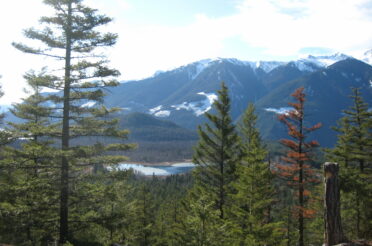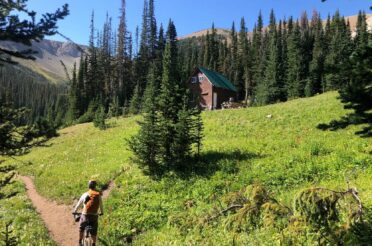Leckie Camp

Summary: Leckie Camp is a great introduction to the wilderness where you can scout for mountain goats, ride up to the wildflower meadows and view Leckie Falls. This story will give you an introduction to this lower-elevation camp.
Hidden away in the south-west corner of the South Chilcotin Mountains Provincial Park is a creek called Leckie. Where it runs close to Slim Creek, we made one of our twenty-five mountain camps. Each camp is built where we feel the energy of the South Chilcotin Mountains most strongly. Leckie Camp is one of these.
Leckie Camp is one of our lowest elevation camps which means it’s accessible year round. In the winter, it’s accessed by an ice bridge – we can literally walk across the frozen creek. When spring comes, the snow melts quickly. It’s mid-May and this will be the first pack trip of the year. Ethan and I have got everything in place for our guests mom and daughter, Jen and Tammy, to experience three days in the wilderness.
After their riding and map orientations on the first day, they are bonded with their horses and ready to hit the trail. Now they have learned to saddle their own horses, they are eager to practise their newly learned skills this morning. Tammy is riding Tepee and is already learning to pay close attention to him, letting him be her wilderness facilitator. Zola is Jen’s horse, they bonded after Jen gave the horse some apple pieces with her oats. My horse is Lorna, she’s a real fast walker and a great pace setter. But we’re not in a rush today so Ethan leads with Pika. She’s a fast horse too, but almost no one is as fast as Lorna. Our pack horse is Nean. After his winter vacation, he’s got plenty of energy and can barely stand still as we pack him up.
The first part of the journey is along the Gun Creek Trail. The water rushes fast beside us, down in the valley. The forest grows lush and green. Birds sing in the trees, we can just hear them over the noise of the water. After two hours, we arrive at Jewel Bridge. We take a short break in the meadow on the other side of Jewel Bridge. There’s a forest service road just on the other side of the meadow and a few vehicles parked as people hike into the Park from the trail head. The horses enjoy the tall grass and soon we are ready to cross the bridge again and continue along the Gun Creek Trail for the rest of our journey.
We look for mountain goats on the rocks across the valley. The mountains here have huge red-grey rocky faces, the perfect place for mountain goats to rest and monitor the area. High up on the rocks, we spot a white dot. When we check with our binoculars, it is indeed a mountain goat and not a rock. Our first wildlife sighting. As part of our conservation efforts, we record all the wildlife we see to determine population numbers and locations. We get our guests involved in this, empowering them to make their contribution.
We come to another bridge where we get off and walk our horses across. Back on our horses, we ride through the forest along the well defined trail. At the point where the trail to Leckie camp branches off, we turn left and ride deeper into the forest. After six hours on the horses, we ride down a slight hill, weave through the trees and soon the barn and corral appear before us. We lead the horses into the corral and tie them to hitching posts while we unsaddle them and feed them oats. We store the saddles in the barn and make the horses dinner, with Jen and Tammy as enthusiastic participants.
Leckie is one of our few camps where we don’t have grazing for the horses. This means they stay in the corral overnight and eat alfalfa cubes that we prepare by soaking in water. Once the horses are fed, it’s time to feed ourselves. All the cooking equipment we need is in the compact cabin. We make a campfire in the fire pit, Jen and Tammy eager to learn how to make a fire. Tonight’s dinner is shepherd’s pie and stir fry. It tastes even better because it’s cooked on the campfire. We finish the evening with marshmallows and hot chocolate around the campfire while we reflect on the successes and challenges of the day. While Jen has ridden a lot, Tammy is new to horses. Today was the longest she ever spent on a horse. Although her muscles are a little sore, she talks enthusiastically about everything she saw and experienced, she can’t wait for tomorrow.
We bed down for the night in our canvas wall-framed tents, a soft foamie pad and our sleeping bags are all we need to fall asleep quickly.
Sleeping in a tent means we naturally wake up at dawn. We’re all excited to get on with the day so we walk down to the corral to feed the horses. We soaked their cubes last night so breakfast is ready for them. We saddle the horses while they eat then walk back up to our camp to make our own breakfast. It’s a warm and sunny morning so we cook over the campfire again – sausages, fried eggs and toast.
We’re all excited to start riding so we clean up and climb up on our horses. This is our only full day at camp so we ride up to the alpine meadows to show Jen and Tammy the wildflowers. We ride through the forest along the Gun Creek Trail, meeting a couple of hikers along the way. As the day warms up, we reach the foothills of the meadows. This early in the season, it is mostly the yellow balsam-roots that fill the meadows. These 18 inch tall sunflower look-alikes are everywhere, waving in the slight breeze. We follow the trail up the mountain, zig-zagging as it gets steeper. Once we’re up high, we can see into the next valley and follow more meadows up to Mount Sheba, the tallest mountain in the South Chilcotin Mountains Provincial Park. It’s identifiable by its distinctive twin peaks. We use this mountain for navigating and explain this to Jen and Tammy. The meadows seem endless, reaching to the top of the mountain and across to the horizon. It’s lunch time and we can’t think of a better spot to sit down and enjoy our sandwiches, the horses grazing contentedly around us. Later in the season, the balsam-root will be interspersed with purple lupine, red columbine and orange tiger-lily but now we appreciate the sea of yellow, dotted with a few white wild potato flowers.
Once we’ve finished eating and check the meadows for any signs of bears or deer, we ride back down the trail. As soon as there is green grass on the mountains, the bears are around, grazing in the meadows.
On the way back, we stop to point out wild onions that at this point in their life-cycle look like nothing more than a long blade of grass. In a few weeks, they’ll have purple flowers and are more identifiable. Now they’re almost impossible to tell the difference from death camas unless you know what you’re looking for. This can sure be a dangerous mistake so we explain the difference to Tammy and Jen. Wild onions have a darker stem, death camas is a brighter almost acid green. The leaves of death camas are triangular in shape. Wild onions smell like an onion, death camas doesn’t. Back at camp, we are ready to cook up dinner and pack up for the ride back tomorrow.
We saddle up the horses, Tammy and Jen now well practised at doing it themselves. We pack our gear back on Nean and hit the trail. On the way back to the ranch, we make a stop at Leckie Falls, it’s not far off the trail.
We ride close to the falls, tie our horses up to trees and walk the last part of the trail. The falls are only accessible by walking out onto a rocky finger. The effort is worth the view. The fall is narrow but tall and we watch the water cascade down to the rocks below. Rainbows bounce off the rocks where the water hits them. Tammy and Jen are captivated.
Once we’ve seen our fill, we walk back to the horses and ride back to the Gun Creek Trail. As we ride, we make sure Jen and Tammy make the most of their final nature connection opportunity of this trip and reflect on the successes and challenges of the last few days. Tammy says she feels empowered by learning to saddle Tepee. Jen talks mostly about the nature connection she feels from seeing the wildflowers and landscapes.
Charlie



